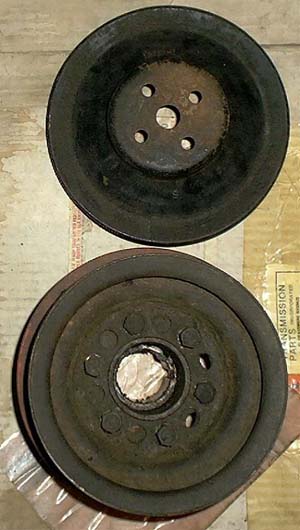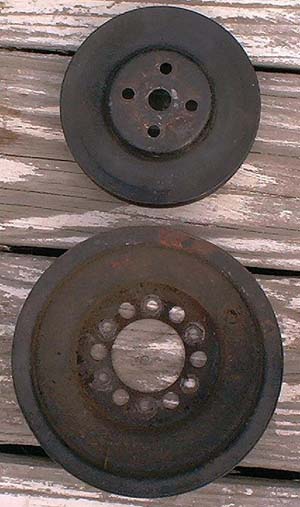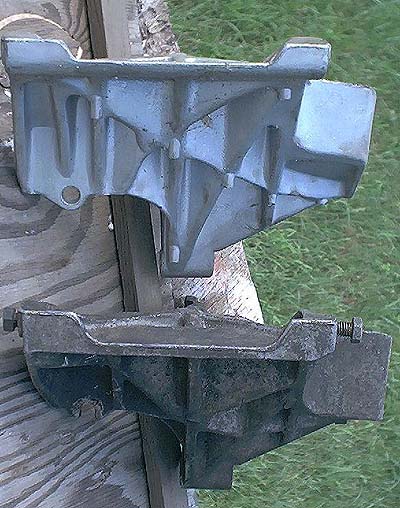
Here is some information on the pulleys and brackets that were used over the years on the 400-430-455. What follows is what I have seen in regard to the many engines I dismantled or worked on. Others may have things that vary as, with any production vehicle, exceptions and changes do occur.
Pulleys and brackets that go along with the different pumps need
to be correct in order to have the proper cooling characteristics and belt
alignment.
The first breakdown is by year. 67-70 used the short length pump and 71-76
used the long length.
There are 2 types of pulleys setups used for both breakdowns. Air conditioning
models and non A/C.
The following picture is of the pulley system used in the non A/C setup.

The p/n's for these pulleys are stamped on them and are as follows:
water pump - 1375141 dia. 6 3/4 " one groove
balancer - 1375142 dia. 6 1/4 " two groove
The water pump used with these pulleys is the 6 blade pump. The pump
pulley is approx. 1/2" greater in diameter than the drive pulley on
the balancer.
It appears that this was done in order to reduce the speed of the water
pump to compensate for the additional flow generated by the 6th blade on
the impeller.
This is just an assumption on my part.
The following pic is of the 67-70 A/C pulleys:

The p/n's for them are also stamped on them and are as follows:
water pump - 1375146 dia. 5 5/8" two groove
balancer - 1375143 dia. 7 3/8" three groove, with one groove 5 3/4"
This setup is used with the 5 blade water pump which is likely the
most common one available for the 67-70 BBB. To my knowledge, the 6 blade
is no longer found in parts stores.
These pulleys increase the speed of the water pump (and clutch fan) significantly.
The intent may have been to speed up the fan to increase air flow at lower
speeds when the A/C was used. The water pump had less blades to slow the
speed of the coolant through the block and radiator allowing it time to
be cooled in radiator.
Using this pulley setup with a 6 blade pump could result in excessive flow
and cause overheating at highway speeds as there may not be sufficient time
for heat transfer in the radiator.
The following pic is of the pulley setup used on the 71-73 with A/C:

The p/n's for these are stamped on them and are as follows:
water pump - 1235778 dia. 5 3/4" two groove
balancer - 1235777 dia. 7 1/4" three groove, with one groove 5 3/4"
air pump (72-73) 1238511 dia. 4 3/16"
These pulleys are VERY similar in appearance to the 67-70 A/C setup.
However, due to the change in water pump length, there will be a mis-alignment
of belts.
The only belt that may be aligned is the power steering on. The alternator
and A/C belts would likely be significantly off.
This can be even more of a problem if the wrong alternator/compressor bracket
is used as well (more to follow on that).
While I don't have pictures of the non A/C pulleys for the 71-73,
the p/n's are as follows:
water pump - 1238156 dia. 5 3/4" one groove
balancer - 1235779 dia. 6 1/4" two groove, with one groove 5 3/4"
air pump (72-73) 1238512 dia. 5"
It is important to note that these pulleys continued to use the 6
blade short length water pump used from 67-70. Keep in mind that the Stage
1 cars used the A/C pump and pulleys as it was part of the package. The
chances of finding a non A/C car is unlikely, but possible.
Using these non A/C pulleys with the 5 blade pump could cause reduced coolant
speed and possible overheating at idle or low during low speed driving.
The 74-76 p/n's (my parts book is only 75) are as follows:
A/C
water pump - 1244057 (no info on dia., or grooves) could be 3 groove for
the A.I.R. pump.
balancer - 1235777 dia. 7 1/7" (same as 71-73)
Non A/C
water pump - 1244761 (no info on dia., could be 2 groove for the A.I.R.
pump.
balancer - 1235779 dia. 6 1/4" (same as 71-73)
Also note, my parts book does not list the 6 blade water pump past 72. However, pulleys are listed for non A/C models. It could be an omission and the 6 blade pump fits up through 76.
Alternator brackets vary over the years as well. From 1964-74 the
non A/C bracket is the same with one minor exception. They will interchange,
and the belt will line up with the non A/C pulleys.
However, the early brackets had an extra casting in the area of the bolt
that later cars with the coil bracket did not have. The casting needs to
be ground down in order to use the coil bracket.
I don't have any pictures available of the early bracket, but can post the
later style at another time.
From 1967-70 the A/C brackets were made out of aluminum. There are
two p/n's for these brackets, however there may be several different casting
numbers for similar types.
Below is a picture of the two types for comparison.

The p/n's for these brackets are as follows:
67-68 All p/n 1381728 (lower bracket)
69-70 Riviera p/n 1381728 (lower bracket)
69-70 All Except Riviera p/n 1231871 (upper bracket)
Oddly enough, the casting number on the upper one in the picture
is 1387208 which is not listed in any parts book I presently have. Dimensionally,
it is the same as other brackets I have with the 1231871 casting. However
there are some minor differences in the design of the casting. One has 5
small holes the other has 3 as well as some different webbing.
It appears to be a case of the later p/n superceding what may have been
used in production as Duane has indicated several times.
The significant difference between the two brackets is the height at which
the compressor sits on the motor. The lower bracket positions the compressor
at a lower height.
This height difference affects the length of the belt used and the upper
steel bracket needed to position and support the compressor.

The p/n's for the brackets are as follows:
67 400/430, 68 All p/n 1379943
69-70 Riviera p/n 1379943
69-70 All except Riviera p/n 1387136
The picture on the left is the 67-68 and 69-70 Riviera bracket. The
one on the right is the 69-70 one excluding Riviera. Notice how the one
on the left is curved to position the compressor lower. Also notice the
different position for the brace rod that attaches to the timing cover.
Mismatching aluminum brackets and steel braces will cause multiple problems
in trying to mount the compressor. As long as the styles are kept together,
they can be used. However, there may be belt length issues as the repostioning
of the compressor may not allow the listed p/n for the belt to fit properly.